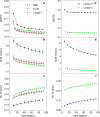New suggestions for the mechanical control of bone remodeling
- PMID: 19373504
- PMCID: PMC2709883
- DOI: 10.1007/s00223-009-9242-x
New suggestions for the mechanical control of bone remodeling
Abstract
Bone is constantly renewed over our lifetime through the process of bone (re)modeling. This process is important for bone to allow it to adapt to its mechanical environment and to repair damage from everyday life. Adaptation is thought to occur through the mechanosensitive response controlling the bone-forming and -resorbing cells. This report shows a way to extract quantitative information about the way remodeling is controlled using computer simulations. Bone resorption and deposition are described as two separate stochastic processes, during which a discrete bone packet is removed or deposited from the bone surface. The responses of the bone-forming and -resorbing cells to local mechanical stimuli are described by phenomenological remodeling rules. Our strategy was to test different remodeling rules and to evaluate the time evolution of the trabecular architecture in comparison to what is known from micro-CT measurements of real bone. In particular, we tested the reaction of virtual bone to standard therapeutic strategies for the prevention of bone deterioration, i.e., physical activity and medications to reduce bone resorption. Insensitivity of the bone volume fraction to reductions in bone resorption was observed in the simulations only for a remodeling rule including an activation barrier for the mechanical stimulus above which bone deposition is switched on. This is in disagreement with the commonly used rules having a so-called lazy zone.
Figures






Similar articles
-
Local mechanical stimuli regulate bone formation and resorption in mice at the tissue level.PLoS One. 2013 Apr 24;8(4):e62172. doi: 10.1371/journal.pone.0062172. Print 2013. PLoS One. 2013. PMID: 23637993 Free PMC article.
-
On mechanically driven biological stimulus for bone remodeling as a diffusive phenomenon.Biomech Model Mechanobiol. 2019 Dec;18(6):1639-1663. doi: 10.1007/s10237-019-01166-w. Epub 2019 May 17. Biomech Model Mechanobiol. 2019. PMID: 31102081
-
Long-term prediction of three-dimensional bone architecture in simulations of pre-, peri- and post-menopausal microstructural bone remodeling.Osteoporos Int. 2005 Mar;16 Suppl 2:S25-35. doi: 10.1007/s00198-004-1701-7. Epub 2004 Aug 31. Osteoporos Int. 2005. PMID: 15340800
-
The cellular transducer in bone: What is it?Technol Health Care. 2006;14(4-5):367-77. Technol Health Care. 2006. PMID: 17065758 Review.
-
If bone is the answer, then what is the question?J Anat. 2000 Aug;197 ( Pt 2)(Pt 2):145-56. doi: 10.1046/j.1469-7580.2000.19720145.x. J Anat. 2000. PMID: 11005707 Free PMC article. Review.
Cited by
-
Local mechanical stimuli regulate bone formation and resorption in mice at the tissue level.PLoS One. 2013 Apr 24;8(4):e62172. doi: 10.1371/journal.pone.0062172. Print 2013. PLoS One. 2013. PMID: 23637993 Free PMC article.
-
Manual Therapy Facilitates Homeostatic Adaptation to Bone Microstructural Declines Induced by a Rat Model of Repetitive Forceful Task.Int J Mol Sci. 2022 Jun 13;23(12):6586. doi: 10.3390/ijms23126586. Int J Mol Sci. 2022. PMID: 35743030 Free PMC article.
-
Mineral density differences between femoral cortical bone and trabecular bone are not explained by turnover rate alone.Bone Rep. 2020 Oct 31;13:100731. doi: 10.1016/j.bonr.2020.100731. eCollection 2020 Dec. Bone Rep. 2020. PMID: 33392366 Free PMC article.
-
Single bout short duration fluid shear stress induces osteogenic differentiation of MC3T3-E1 cells via integrin β1 and BMP2 signaling cross-talk.PLoS One. 2013 Apr 11;8(4):e61600. doi: 10.1371/journal.pone.0061600. Print 2013. PLoS One. 2013. PMID: 23593489 Free PMC article.
-
Mechanical regulation of bone formation and resorption around implants in a mouse model of osteopenic bone.J R Soc Interface. 2019 Mar 29;16(152):20180667. doi: 10.1098/rsif.2018.0667. J R Soc Interface. 2019. PMID: 30890053 Free PMC article.
References
-
- {'text': '', 'ref_index': 1, 'ids': [{'type': 'DOI', 'value': '10.1146/annurev.matsci.28.1.271', 'is_inner': False, 'url': 'https://doi.org/10.1146/annurev.matsci.28.1.271'}]}
- Weiner S, Wagner HD (1998) The material bone: structure–mechanical function relations. Annu Rev Mater Sci 28:271–298
-
- {'text': '', 'ref_index': 1, 'ids': [{'type': 'DOI', 'value': '10.1039/b402005g', 'is_inner': False, 'url': 'https://doi.org/10.1039/b402005g'}]}
- Fratzl P, Gupta HS, Paschalis EP, Roschger P (2004) Structure and mechanical quality of the collagen-mineral nano-composite in bone. J Mater Chem 14:2115–2123
-
- {'text': '', 'ref_index': 1, 'ids': [{'type': 'DOI', 'value': '10.1016/j.pmatsci.2007.06.001', 'is_inner': False, 'url': 'https://doi.org/10.1016/j.pmatsci.2007.06.001'}]}
- Fratzl P, Weinkamer R (2007) Nature’s hierarchical materials. Prog Mater Sci 52:1263–1334
-
- {'text': '', 'ref_index': 1, 'ids': [{'type': 'DOI', 'value': '10.1038/nmat1866', 'is_inner': False, 'url': 'https://doi.org/10.1038/nmat1866'}, {'type': 'PubMed', 'value': '17401419', 'is_inner': True, 'url': 'https://pubmed.ncbi.nlm.nih.gov/17401419/'}]}
- Taylor D, Hazenberg JG, Lee TC (2007) Living with cracks: damage and repair in living bone. Nat Mater 6:263–268 - PubMed
-
- None
- Currey JD (2002) Bones, structure and mechanics. Princeton University Press, Princeton
Publication types
MeSH terms
LinkOut - more resources
Full Text Sources

